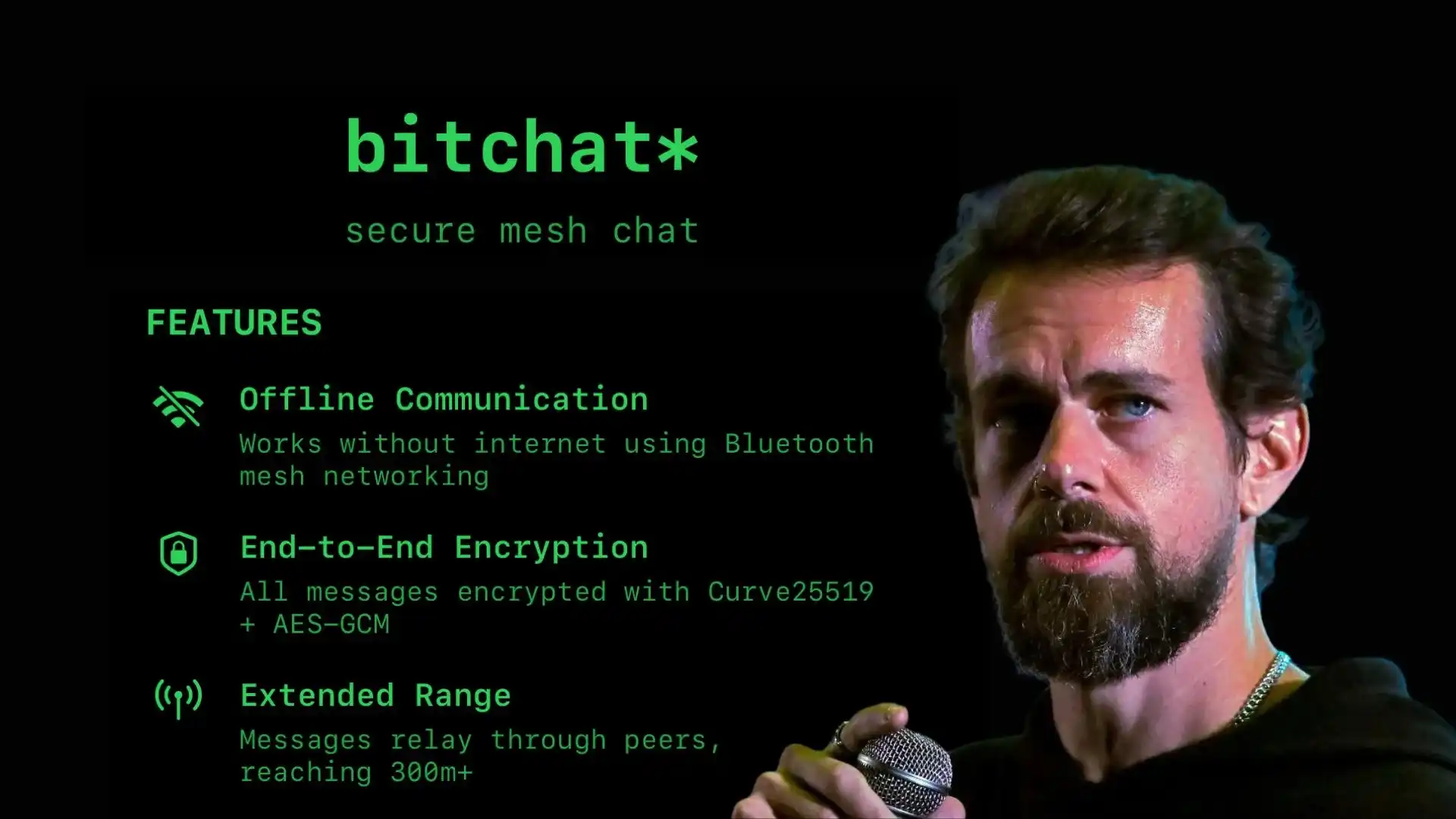
20 years later, Twitter founder Jack Dorsey returns with a new product, bitchat, embracing minimalism.
In the summer of 2006, mobile internet was still a fresh term, feature phones were the mainstream devices in people's hands, and text messaging remained the most convenient form of "mobile socializing." At that time, a project codenamed "twttr" was born. It started with SMS broadcasting, using a minimal character limit and the simplest broadcasting protocol, making "talking to the world anytime, anywhere" possible for the first time.
In that humble office, the founding team was passionately debating functional details, and Jack Dorsey, who was still a college student at the time, sat among them. He turned his communication ideals into reality through the most direct technical path. Twttr quickly grew into Twitter—a product that fundamentally changed the global social ecosystem.
Now, in 2025, time has passed, and both technology and the world have undergone tremendous changes. Wi-Fi signals are ubiquitous in cities, and 5G has connected everything into one vast network. However, the essence of socializing has not changed: we still crave free, genuine, and intermediary-free communication. The reality, however, is not always pleasant—network blind spots, platform crashes, and data leaks can happen anytime, anywhere. The newly acquired Twitter has not only changed its logo and name but has also been reshaped by Musk into a completely new entity.
Jack Dorsey, the legendary figure who once led two publicly traded companies valued at over $5 billion, has long left Twitter and focused his energy on the crypto industry and the development of Block. Yet, he has not completely abandoned his passion for social platforms. Like a young man returning to the design of the "twttr" project in 2006, he spent an ordinary weekend coding through the night to create a new minimalist social product—bitchat.
The only difference is that bitchat incorporates more of Jack Dorsey's beliefs in minimalist protocols, decentralized communication, and information freedom than "twttr."
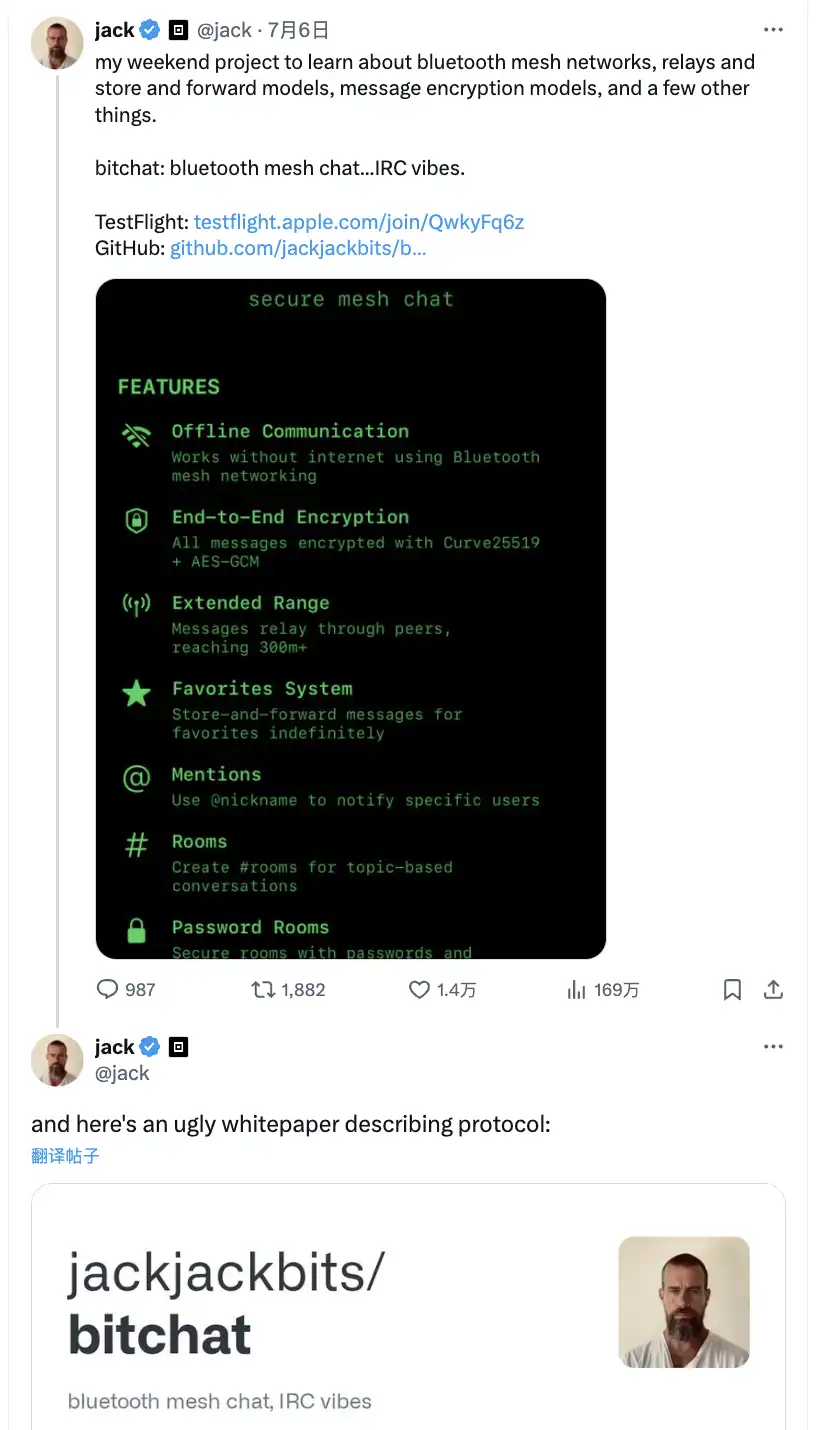
Core Function Highlights
When camping, hiking, or engaging in mountain activities without mobile signal, sharing locations or seeking emergency help; easily forming temporary chat networks with companions in crowded places like music festivals, concerts, sports venues, and comic conventions where networks often crash; establishing emergency communication networks during disasters, power outages, or extreme weather; protecting privacy in social movements, protest sites, or sensitive discussions where tracking participants is difficult; or maximizing brainstorming in closed spaces like universities, summer camps, research groups, or geek gatherings… in these scenarios, bitchat is a great choice.
The biggest highlight of bitchat is that it completely relies on no infrastructure—no servers, no Wi-Fi, and no mobile signals. Each phone acts as both a "transmitter" and a "relay station," discovering each other using Bluetooth Low Energy (BLE).
What attracts the crypto industry is that all messages are end-to-end encrypted. Private chats use encryption technologies like X25519+AES-256-GCM, and group chats can be password-protected, allowing only those who know the password to see the content. Messages are only stored on the device; they automatically disappear upon exit or shutdown, leaving no traces in the background.
Moreover, compared to other encrypted communication products, bitchat completely abandons the "login" process, requiring no phone number, email, or long strings of keys. Each time you go online, a random "user ID" is generated, which can be modified at any time, eliminating concerns about identity tracking.
User Experience
Downloading, Installing, and Using Bitchat
Copy and open the following address on your iPhone's web browser: https://github.com/jackjackbits/bitchat.
Find the TestFlight invitation entry on the page and click "View in App Store" to be redirected to TestFlight. If you haven't installed TestFlight yet, it will prompt you to download it automatically. Once installed, return to the invitation page to see the Beta version of "bitchat mesh."
In TestFlight, install bitchat by clicking the "Install" button. You will see a simple app information page. The installation process takes about 5–10 seconds; wait until the button changes from "Install" to "Open."
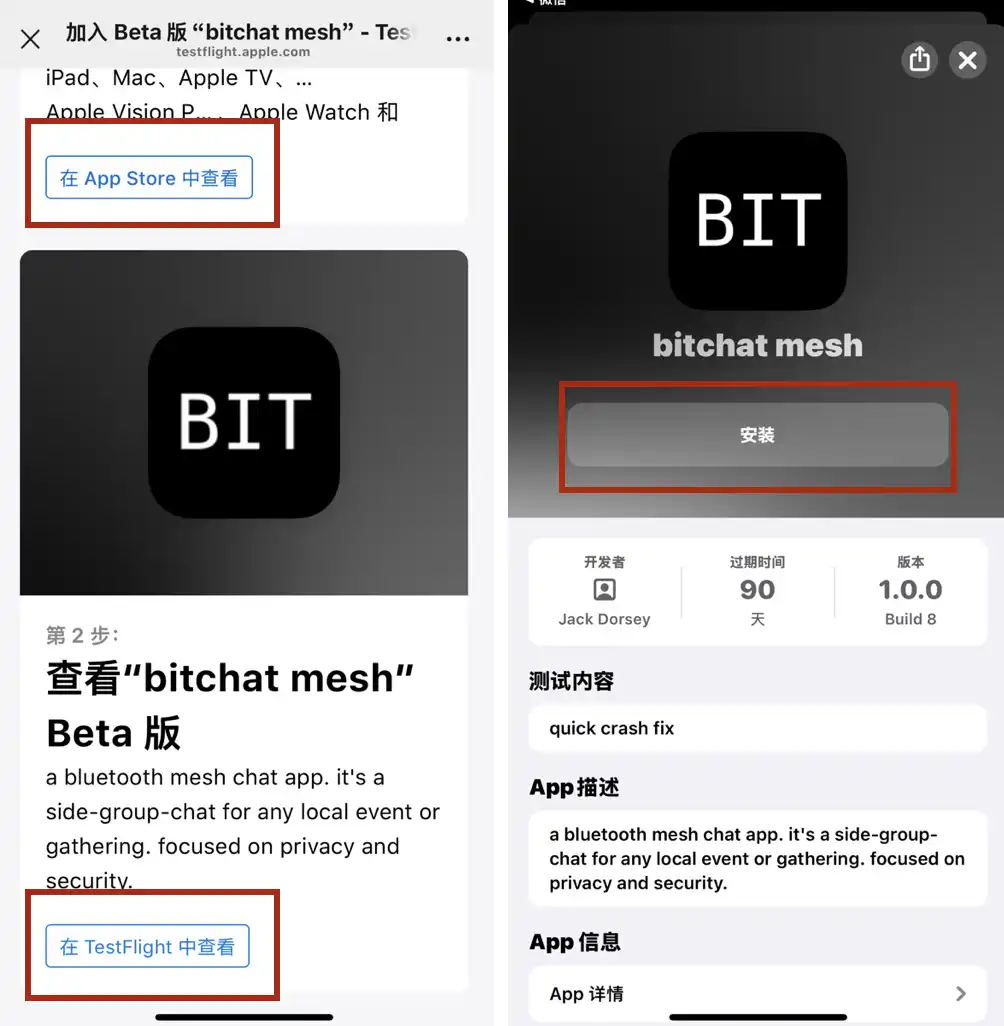
After opening bitchat, the system will prompt for permission: "Allow 'bitchat' to find Bluetooth devices?" The message states: bitchat uses Bluetooth to create a secure mesh network for chatting with nearby users. Click "Allow" to enable bitchat to scan and connect to nearby devices in the background, ensuring the message relay function works properly.
Since it is still in the testing phase, it will prompt you to share feedback with the developers; simply click "Next" to skip this step. Finally, click "Start Testing" to enter the main interface of bitchat.
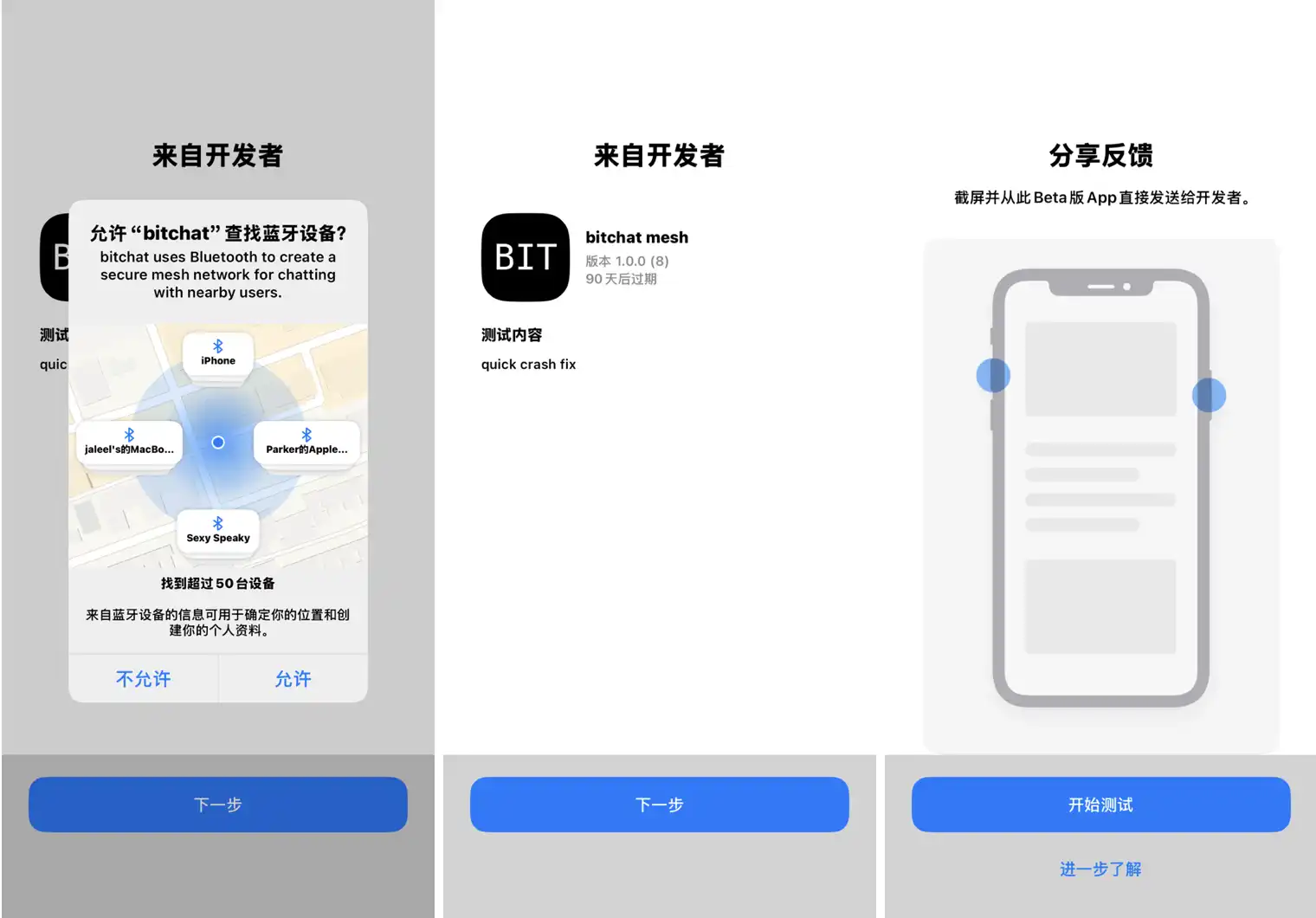
Tip: Make sure your phone's Bluetooth is turned on and allow TestFlight to run in the background; otherwise, you won't be able to find nearby friends' devices.
You will notice that bitchat has no login process; you can use it directly after downloading. In bitchat, every interaction is anonymous and untraceable—no phone number, email, or registration is required, and you can change your nickname at any time. This mechanism maximally protects user privacy, allowing you to communicate without worrying about identity tracking in sensitive situations or special contexts.
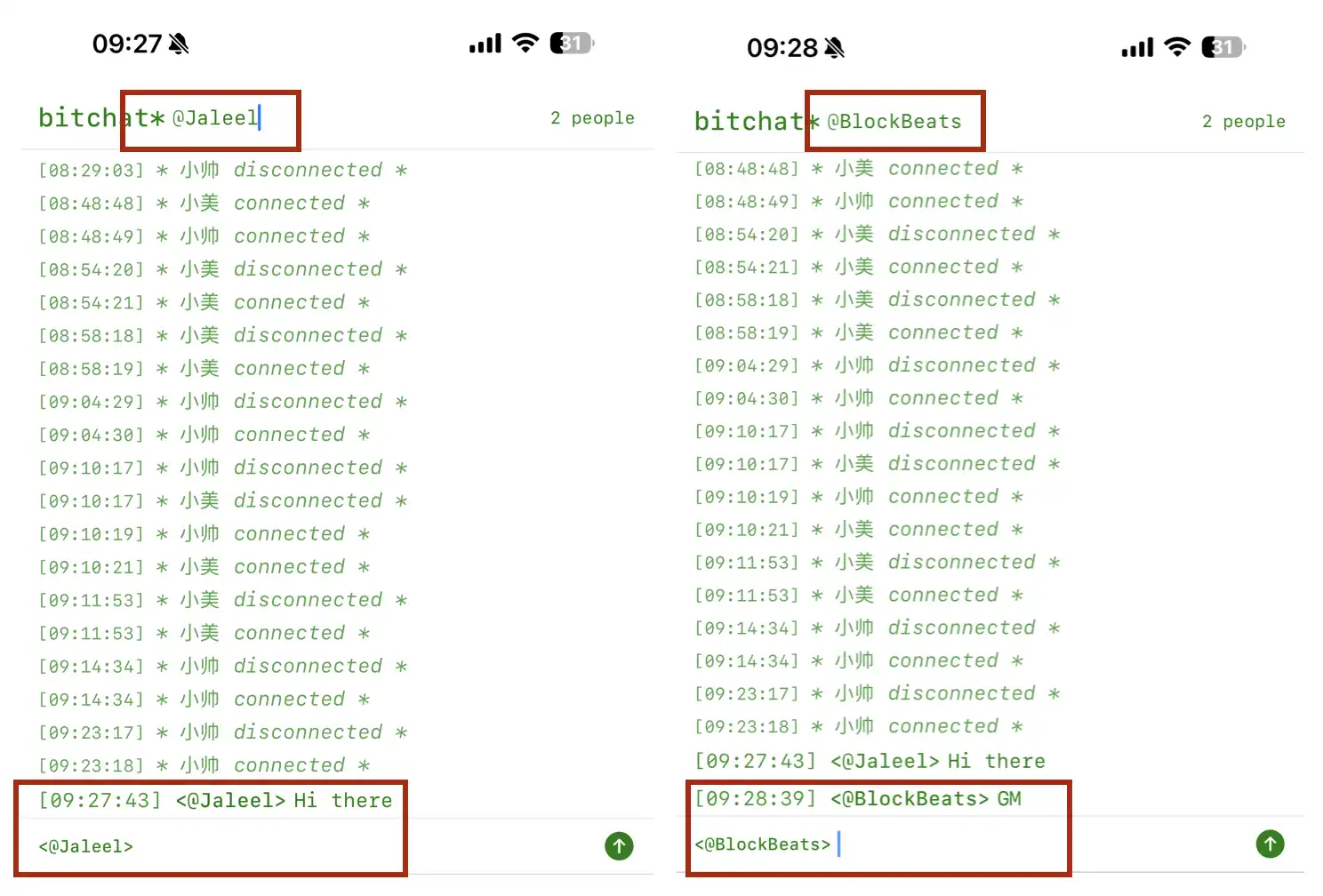
At the top of the page, in the bitchat* @ Current ID area, you can modify your ID at any time. Click on the name after @ to directly edit and save the new ID. The new ID will take effect immediately and will be displayed in the friend list and message header of all users in the same room.
End-to-End Encrypted, Trace-Free Private Chats
After using bitchat for a while, you will see the main interface continuously displaying the online (connected) and offline (disconnected) status of various devices, along with speaking logs, each record preceded by a timestamp.
To prevent "timing analysis" attacks, bitchat adds an additional random delay of 50–500 milliseconds after all operations, ensuring that recorded times do not directly correspond to your real actions, thus preventing "packet sniffing." This feature also helps maintain privacy and prevent identity tracking in sensitive situations or special contexts.
Bitchat supports true end-to-end encryption, meaning that only you and the other party (or group members) can read each message, and even the relay devices cannot decrypt it. Whether in private or group chats, the content remains secure and private, not intercepted by platforms or third parties.
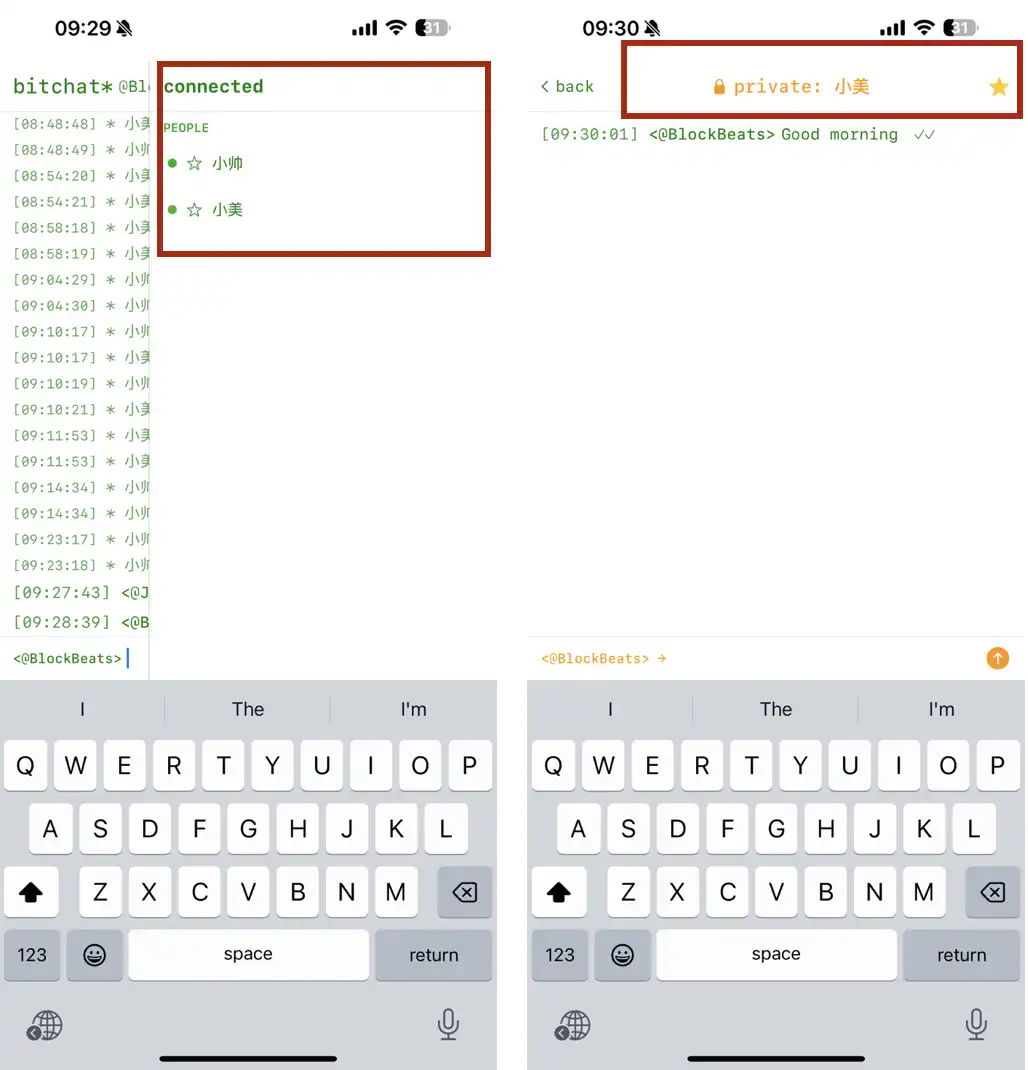
In the upper right corner of the page, there is a small person icon. Clicking it will list all currently online peers: a green dot indicates online, while a gray cross indicates just offline. For frequently chatted or important contacts, clicking the star (☆) next to their name allows you to "favorite" them. Once favorited, a star will appear next to that contact for easy identification next time.
In the online list, we click on "Xiao Shuai" to enter the private chat window—at this point, the number of unread messages will be displayed above his device.
When Xiao Shuai opens the notification, he will see that the sender is "@BlockBeats>", and by entering, he can view the complete chat history. Private chats are also end-to-end encrypted, and the conversation content cannot be decrypted by observing nodes. All messages here will also have timestamps with random time perturbations, ensuring privacy and resistance to traffic analysis.
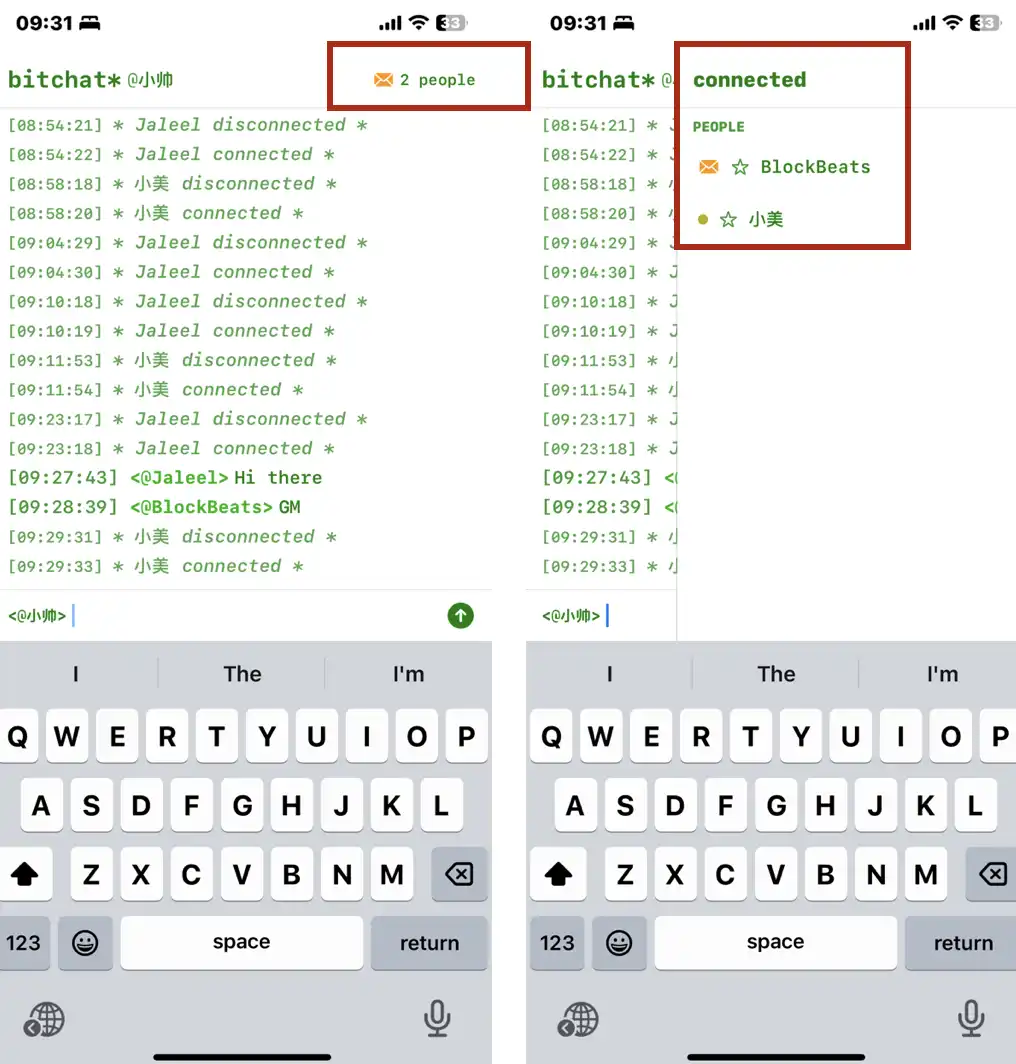
Creating Rooms and Other Advanced Commands
Now, the question arises: the privacy of public conversations isn't that great. How can we conduct private conversations with multiple people?
At any time, simply type a / in the input box, and a complete command list will pop up at the bottom of the screen:
For example, /j corresponds to: join or create a room. If the specified room already exists, you will join it directly; if it doesn't exist, a new room will be created, and you will automatically become the owner.
/rooms corresponds to: list all currently discovered (joinable) room names, allowing you to quickly see which rooms are available.
/w corresponds to: view the list of currently online users, showing all online contacts in the same room or network as you.
/m corresponds to: send a private message to a specified user. The format is usually /m @ username message content, which only you and the other party can see.
/clear corresponds to: clear all message records in the current chat window, restoring the interface to its initial blank state.
/pass corresponds to: (only for room owners) set or modify the room access password. After execution, users joining this room will need to enter the password to enter.
/transfer corresponds to: transfer ownership of the room to another online user. The new owner will gain powers such as password management and message retention.
/save corresponds to: (only for room owners) toggle the local message retention switch: when turned on, you can still view historical chats locally after going offline or restarting the app; when turned off, messages are only stored in memory and will be cleared upon exit.
So when creating a room, simply type /j, followed by the desired room name, such as "testroom." After sending, if the room does not exist, the system will automatically create it and set you as the owner. Once created, a prompt will appear on the screen: "joined room #testroom(created new room – you are the owner) *"
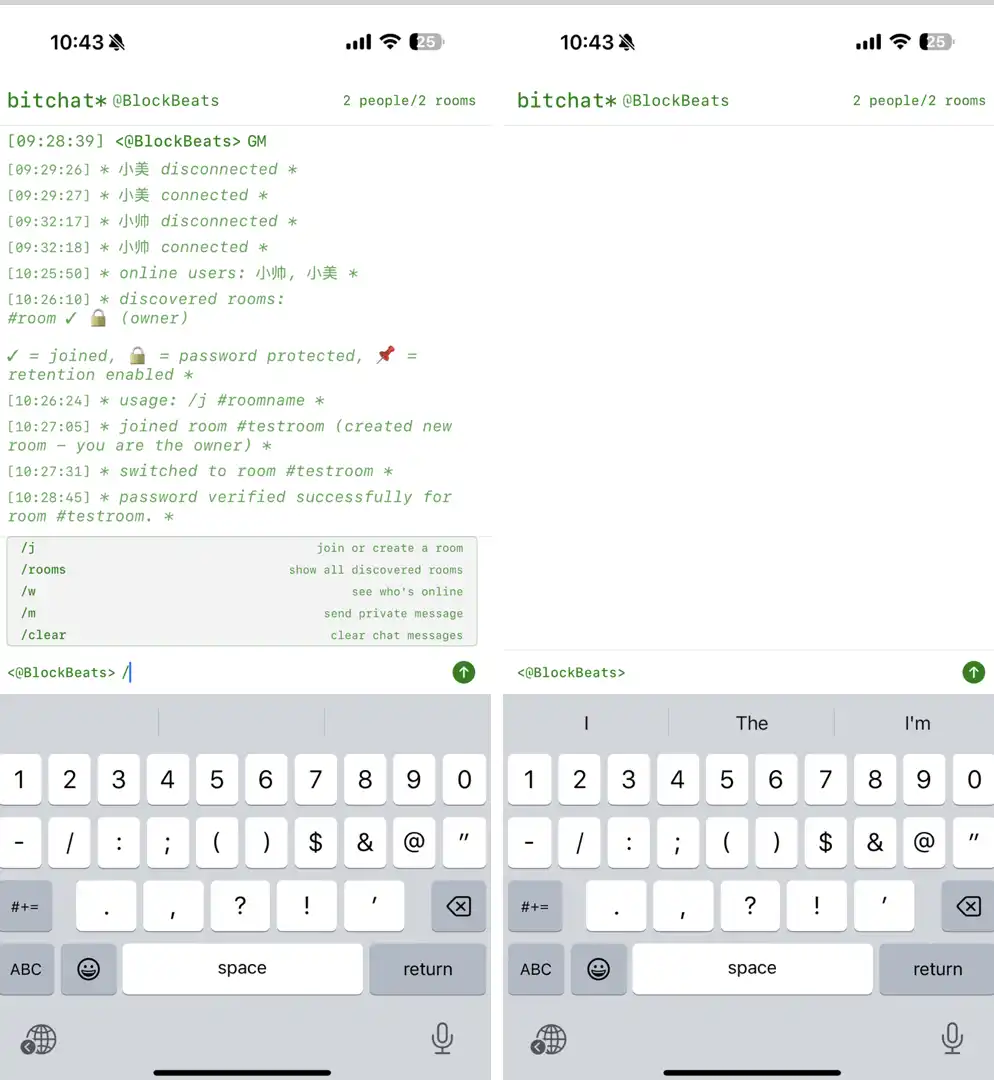
At this point, if Xiao Shuai also wants to enter the private room, he needs to type /j testroom and enter the password in the pop-up password page to gain access to the room.
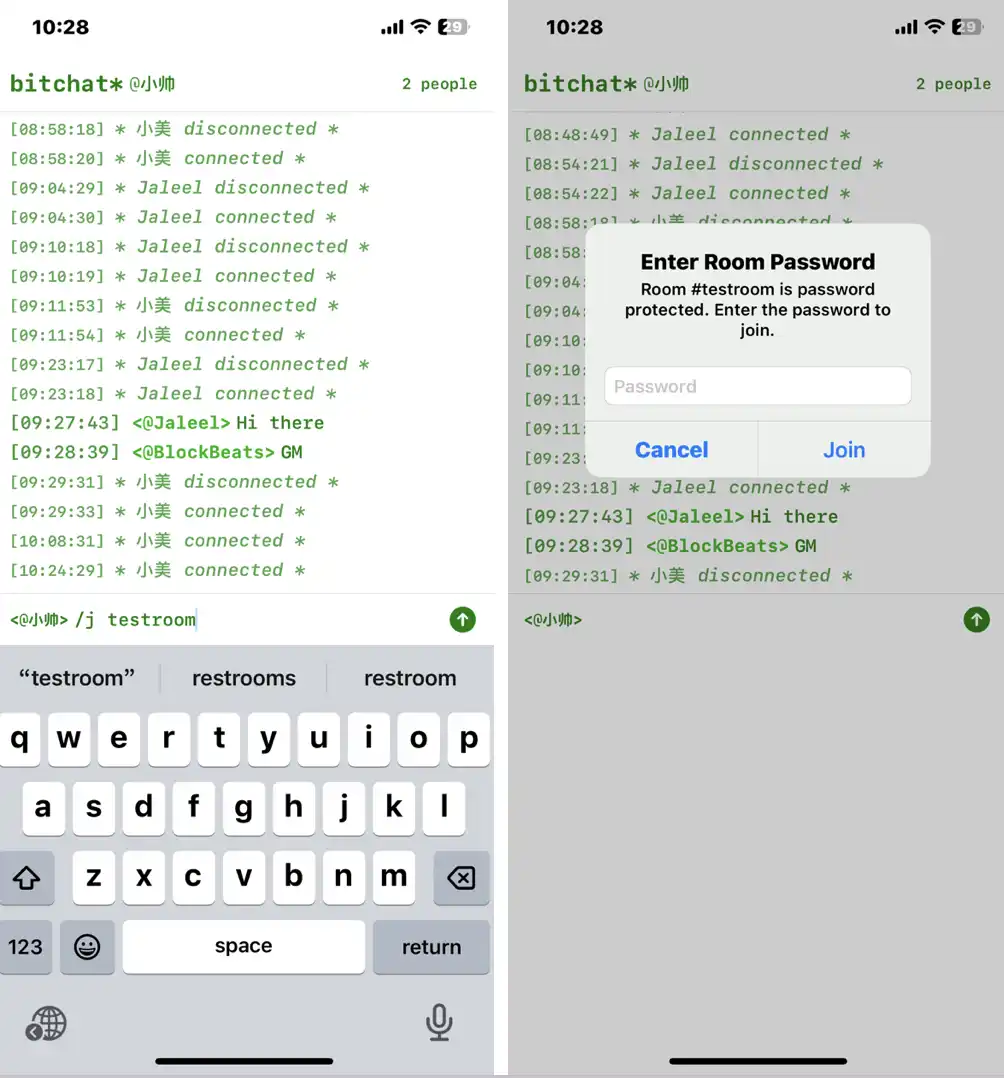
Inside the room, there are also a series of advanced commands. Typing /pass yourSecret will bring up a password input box; once verified, only those holding this password can rejoin, and only the room owner can lock the room or change the password. You can also transfer room ownership within the room by typing /transfer @ other ID. Once the other party accepts, they will automatically become the new owner, gaining full rights for personnel management, password settings, and message retention toggles.
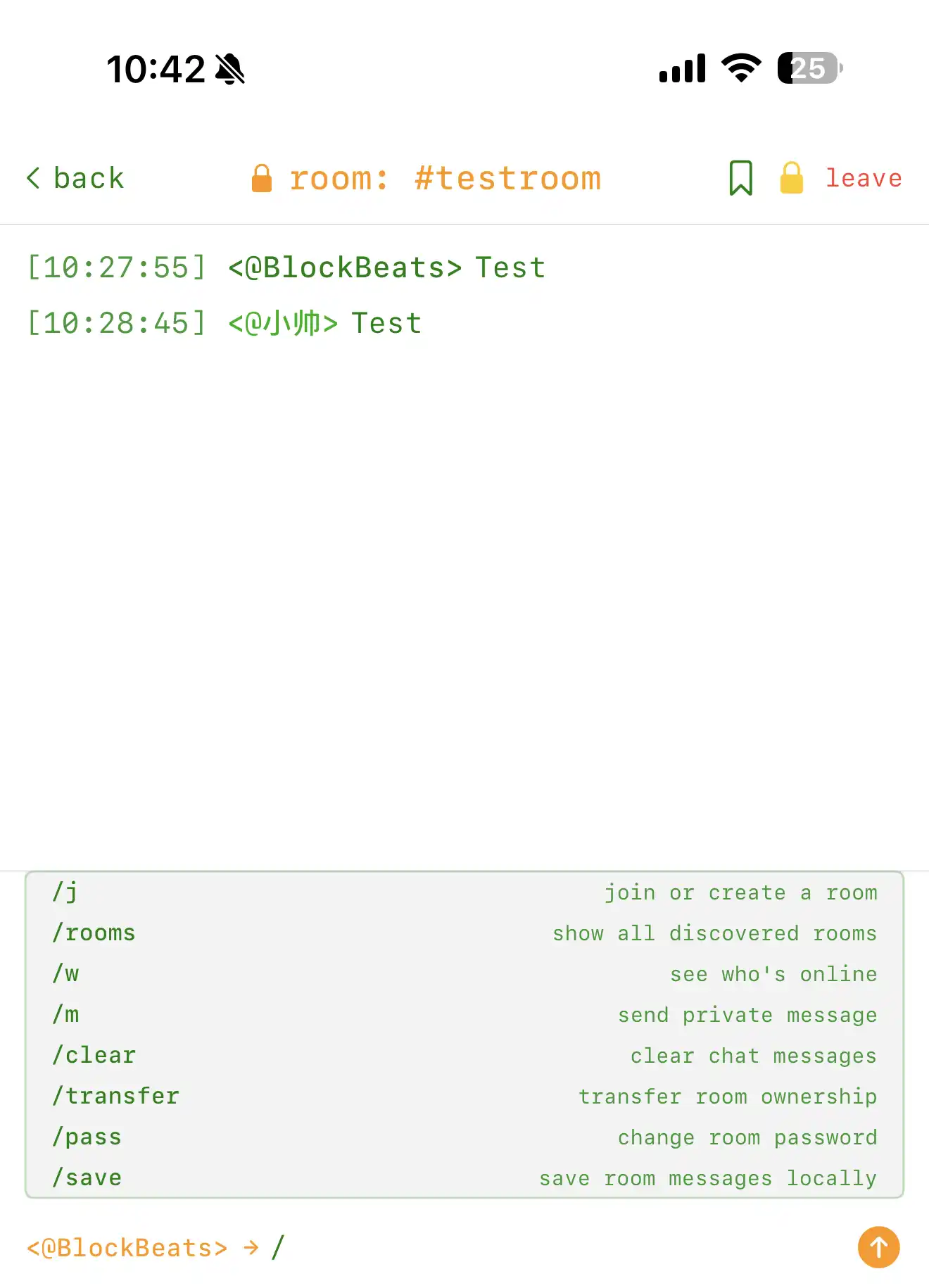
By default, messages in bitchat rooms exist temporarily in memory; the room owner can use /save to enable or disable the "message retention" feature locally. When message retention is enabled, even after restarting the app, you can still view the room's history locally. Typing /save again will disable retention, reverting to the default "messages evaporate immediately" mode.
After mastering the basics of creating rooms, joining rooms, sending and receiving private messages, and viewing online users, the next step involves some advanced commands on the main page, including clearing chat history, viewing online users, and room operations.
If you want to temporarily "clean the battlefield," type /clear in the command line to clear all displayed messages in the current chat window with one click. After cleaning, the screen will be as clean as it was at the start, just like this image shows:
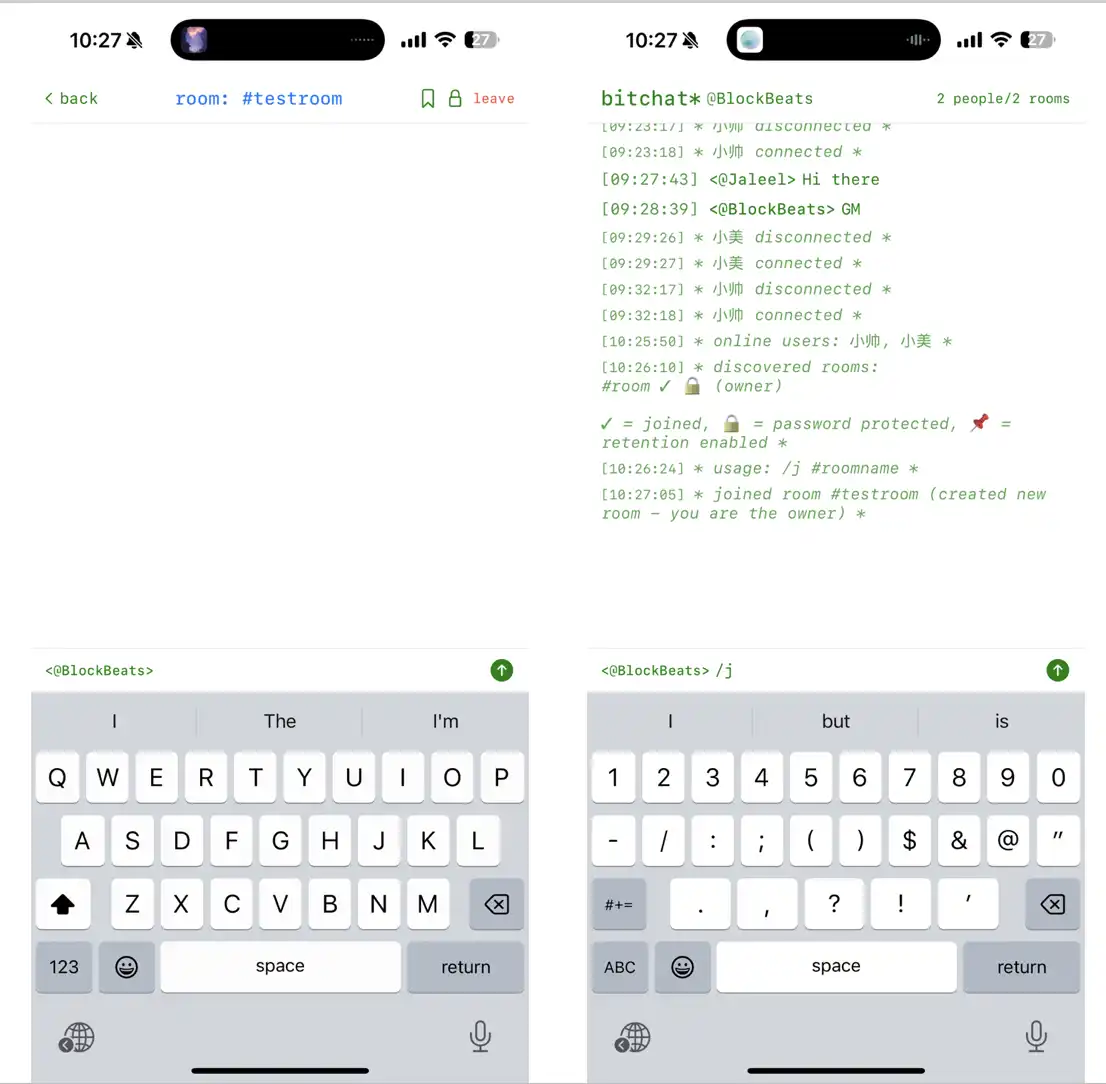
In the future, bitchat mesh will incorporate various transmission methods such as Wi-Fi Direct (250 Mbps, 100 meters), ultrasound, and LoRa, automatically switching based on network and battery levels; it will also optionally connect to the Nostr protocol to bridge local mesh and internet nodes, expanding the communication radius.
You can feel that bitchat perfectly inherits the three core principles of "simplicity, constraints, and craftsmanship" that Jack Dorsey established for Twitter.
This is not the first time Jack Dorsey has built a social protocol after leaving Twitter. For example, in 2024, Jack Dorsey led the incubation of Bluesky from within Twitter, which later became independent. Bluesky is also a decentralized social protocol centered around "relay channels," supporting tens of thousands of community-hosted server nodes, theoretically similar in mechanism to bitchat mesh's BLE multi-hop relay.
The "trustless" spirit advocated by the Bitcoin community is also deeply embedded in the design of bitchat: no central server, no cloud archiving, and even user identities refresh with each restart. Nostr's stateless discovery mechanism and the random delay processing of operations… all these details are aimed at preserving the most fundamental "privacy and freedom."
The emergence of bitchat is Jack Dorsey's personal practice of decentralization and information freedom once again. In today's era, where networks are frequently restricted and data leaks occur often, he has returned social interaction to the users themselves—allowing each conversation to be limited only by the distance of Bluetooth signals, no longer interfered with by any platform, server, or intermediary.
This may be the most anticipated significance of bitchat: it may be small and have many flaws, but from a certain perspective, it could also represent the "twttr" moment in the realm of encrypted communications.
免责声明:本文章仅代表作者个人观点,不代表本平台的立场和观点。本文章仅供信息分享,不构成对任何人的任何投资建议。用户与作者之间的任何争议,与本平台无关。如网页中刊载的文章或图片涉及侵权,请提供相关的权利证明和身份证明发送邮件到support@aicoin.com,本平台相关工作人员将会进行核查。




